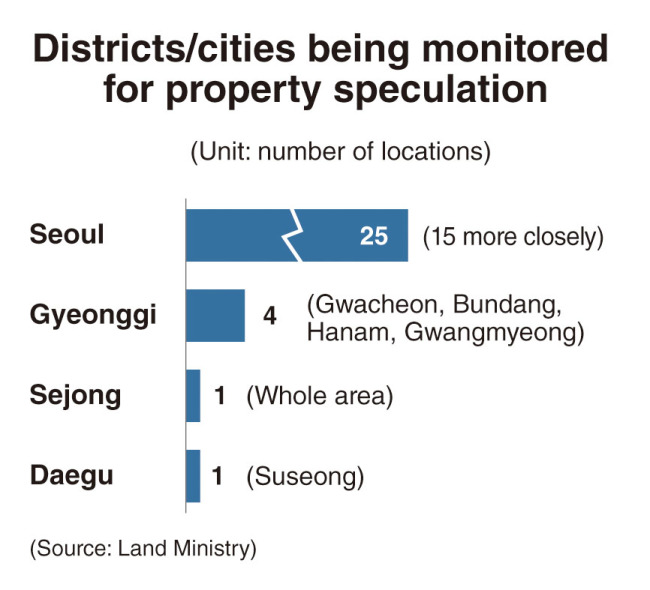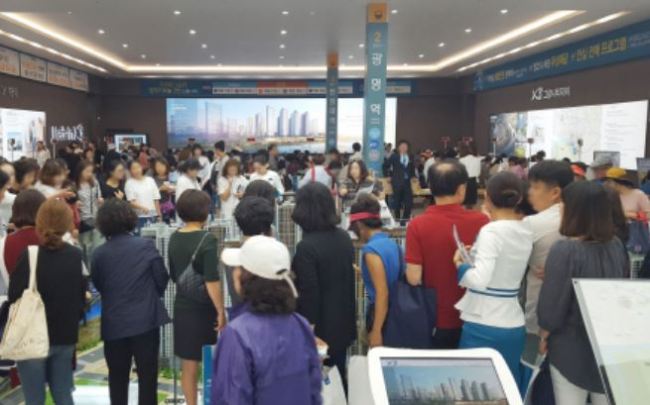[News Focus] Who benefits from Seoul apartment application system?
By Kim Yon-sePublished : Dec. 18, 2018 - 16:47
SEJONG -- Apartment prices in Seoul recorded an all-time high this year. Some complexes in southern districts saw prices shoot up 30 to 50 percent in only two or three years, which made ordinary households scrap their plans to purchase apartments in the capital.
As housing lease prices in Seoul also skyrocketed, many Seoul citizens moved instead to satellite cities in Gyeonggi Province, according to data from real estate information providers. They suffer difficulties in commuting due to the long distances to their workplaces in central or southern Seoul and frequent traffic jams.
Furthermore, if a household relocates outside Seoul, chances are low that it will be able to move back to Seoul. The odds are even lower when Gyeonggi Province residents try to buy new apartments via the state-led application system.
Under rules that favor Seoul residents, applicants living outside of the capital city are classified as second-group candidates, which means they have a de facto zero chance of winning the score-based selection, amid high competition rates of at least about 20-40 to one household, and up to 70 to one in some districts.
First-group candidates should have resided in Seoul for a year or more, with the Residents Registration Law proving the record.
Even if a household has resided in Seoul for more than year via apartment lease, it would not be able to take out a mortgage loan if it owns an apartment in cities in Gyeonggi Province or other regions, under strict regulations handed down to all of the 25 wards in Seoul.
The Land Ministry designates 15 wards, including Gangnam, Seocho, Jongno, Nowon and Dongjak, as speculative areas. The other 10 wards, including Seodaemun, Seongbuk, Gangbuk, Jungnang and Dobong, have been named areas being watched by the state for possible speculation.
As housing lease prices in Seoul also skyrocketed, many Seoul citizens moved instead to satellite cities in Gyeonggi Province, according to data from real estate information providers. They suffer difficulties in commuting due to the long distances to their workplaces in central or southern Seoul and frequent traffic jams.
Furthermore, if a household relocates outside Seoul, chances are low that it will be able to move back to Seoul. The odds are even lower when Gyeonggi Province residents try to buy new apartments via the state-led application system.
Under rules that favor Seoul residents, applicants living outside of the capital city are classified as second-group candidates, which means they have a de facto zero chance of winning the score-based selection, amid high competition rates of at least about 20-40 to one household, and up to 70 to one in some districts.
First-group candidates should have resided in Seoul for a year or more, with the Residents Registration Law proving the record.
Even if a household has resided in Seoul for more than year via apartment lease, it would not be able to take out a mortgage loan if it owns an apartment in cities in Gyeonggi Province or other regions, under strict regulations handed down to all of the 25 wards in Seoul.
The Land Ministry designates 15 wards, including Gangnam, Seocho, Jongno, Nowon and Dongjak, as speculative areas. The other 10 wards, including Seodaemun, Seongbuk, Gangbuk, Jungnang and Dobong, have been named areas being watched by the state for possible speculation.

“A newly built apartment of 84 square meters hovers at 1.5 billion won ($1.3 million) to 2 billion won in Gangnam, and 700 million won to 1.3 billion won in other wards,” said a real estate agent in Yeouido. “It is nearly impossible for ordinary households in Gyeonggi Province without bank loan support.”
He pointed out that even applicants who do not own homes are banned from taking housing-collateralized loans if they apply for an apartment with a parcel price that exceeds 900 million won.
A civil servant in the administrative city of Sejong said, “The Land Ministry has continued to revise the apartment subscription system for houseless applicants.”
Nonetheless, he shared the view of some netizens, who claim that sons and daughters of wealthy citizens residing in Seoul benefit from the current system, as they have enough cash to satisfy parcel prices and are eligible to apply under the system.
A netizen said, “Gyeonggi Province residents have no eligibility to buy Seoul apartments, and those who do not own homes don’t have sufficient cash. This means the system is for the high-income bracket in Seoul, who have a high-priced lease for higher scores in the houseless segment in selection.”

Konkuk University professor Shim Kyo-eon was quoted by a news outlet as saying that “the policy to curb housing prices by seeking to crack down on owners of multiple houses is ambiguous in itself. It is a matter of demand and supply.”
Shim also expressed skepticism over the third phase of new towns in four or five locations in Gyeonggi Province, which are to be designated by the Land Ministry.
“It takes about seven years to foster new towns. And the towns located more than 40 minutes away by transportation would have not much impact on Seoul apartment prices,” he said.
A resident of Jungdong, part of the first phase of new towns in the western Gyeonggi Province city of Bucheon, said, “It takes three hours or more for a round trip to my workplace in Gwanghwamun, Seoul, by driving. The government and constructors have built apartments en masse in the outskirts of Seoul for decades without constructing sufficient outer roads.”
He added that he gave up moving to Seoul, where he was born and educated, due to the big price gap of about 500 million won for an apartment of the same size in the two neighboring cities.
By Kim Yon-se (kys@heraldcorp.com)







![[KH Explains] Hyundai's full hybrid edge to pay off amid slow transition to pure EVs](http://res.heraldm.com/phpwas/restmb_idxmake.php?idx=644&simg=/content/image/2024/04/18/20240418050645_0.jpg&u=20240419100350)






![[From the Scene] Monks, Buddhists hail return of remains of Buddhas](http://res.heraldm.com/phpwas/restmb_idxmake.php?idx=652&simg=/content/image/2024/04/19/20240419050617_0.jpg&u=20240419175937)

![[KH Explains] Hyundai's full hybrid edge to pay off amid slow transition to pure EVs](http://res.heraldm.com/phpwas/restmb_idxmake.php?idx=652&simg=/content/image/2024/04/18/20240418050645_0.jpg&u=20240419100350)

![[Today’s K-pop] Illit drops debut single remix](http://res.heraldm.com/phpwas/restmb_idxmake.php?idx=642&simg=/content/image/2024/04/19/20240419050612_0.jpg&u=)